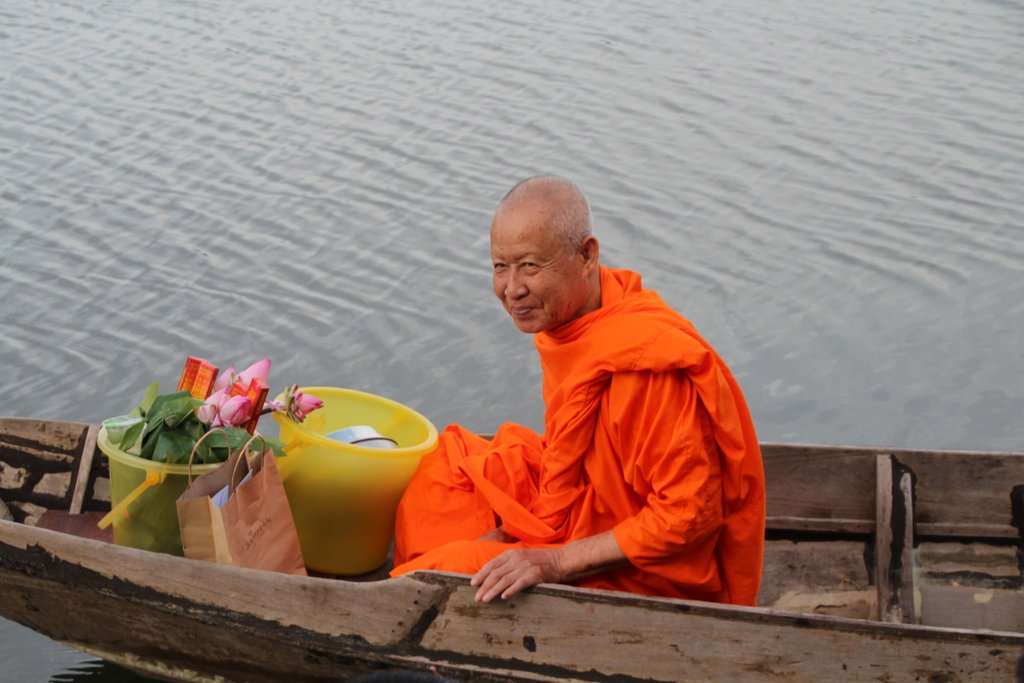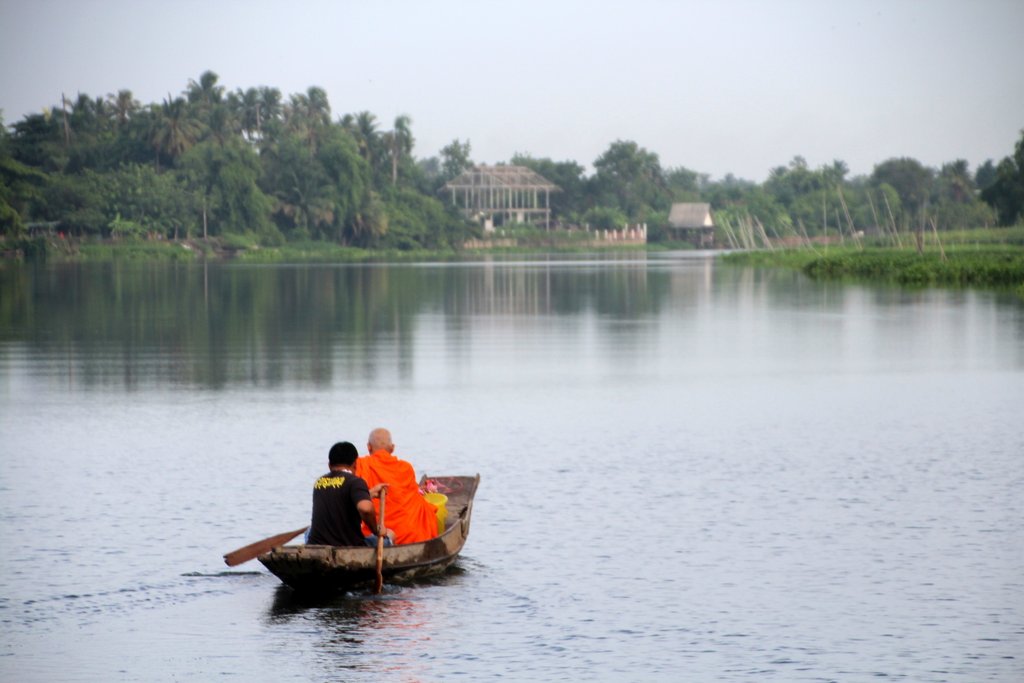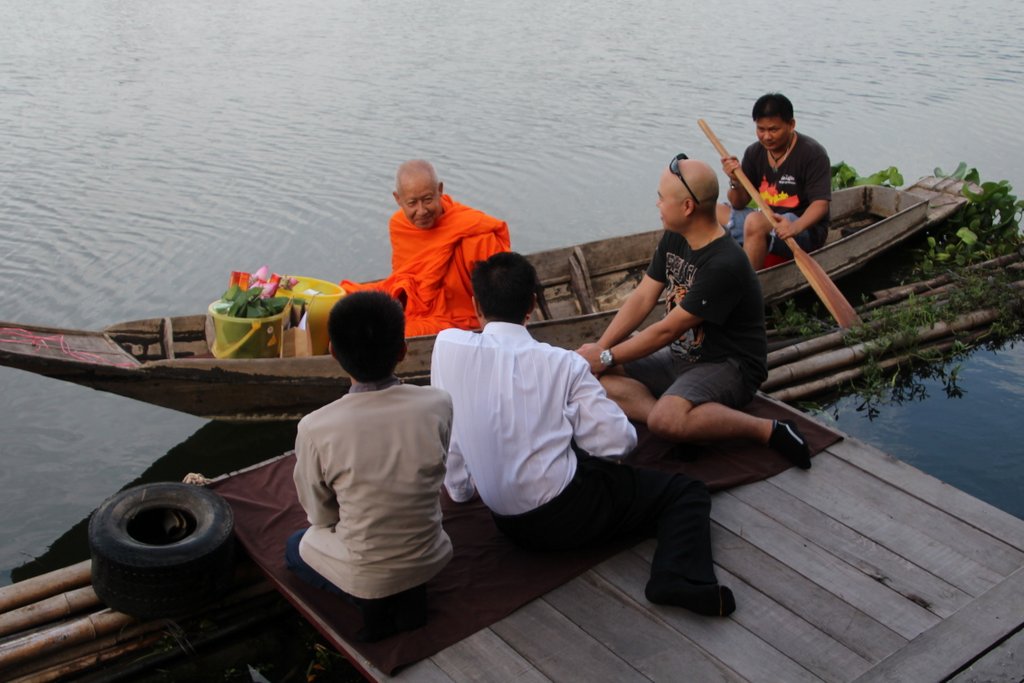Have you experienced a Thai Monk Blessing Ceremony? Even for someone like me who isn’t religious, it left a lasting impression. The gratitude stayed with me all day, reminding me to reflect on the richness of life and the amazing people who fill it. Sometimes, it’s the smallest moments that bring the deepest appreciation. Feeling blessed and fortunate for it all. Here’s how to discover the profound beauty of blessings in Thailand and immerse yourself in Thai spiritual traditions.
Counting My Blessings with a Thai Monk Blessing Ceremony
I left my cool room and comfortable bed in Sampran Riverside in Nakornpathom, just an hour’s drive from Bangkok, and walked down to the jetty to await the arrival of a monk from the local monastery which was visible in the distance on the other side of the river.
The Tachine River, or the Tha Chin River, is a distributary of the Chao Phraya River in central Thailand. It branches off from the Chao Phraya River near the town of Chainat and flows through several provinces, including Suphanburi, Nakhon Pathom, and Samut Sakhon, before emptying into the Gulf of Thailand. The river plays an important role in agriculture and local livelihoods, providing water for rice paddies, fisheries, and surrounding communities. The areas along the Tha Chin River offer scenic views of rural Thailand and are known for their cultural and spiritual landmarks.
I really didn’t know what to expect at a Thai monk blessing ceremony as I’ve never encountered a monk before in my travels and five years of secondary schooling at a school run by the Lutheran church has left me with an intense dislike of anything connected with religion.
Exploring Thai traditions with a Thai monk blessing ceremony

Welcome and Thank You!
Greetings and welcome to Eat, Drink, and Be Kerry! We’re thrilled to have you join our community of food and travel enthusiasts. Your support means the world to us, and we’re grateful for the time you’ve taken to explore our content. If you’re enjoying what you find here, feel free to leave a comment, give us a “like,” share with friends, and consider subscribing for even more culinary and travel delights! Just a heads up—this page has some affiliate links. If you decide to buy something through one of these links, I might earn a small commission, but don’t worry, it won’t cost you anything extra. Thanks a bunch for your support!
Explore Thai Traditions
A monk’s blessing in Thailand holds deep spiritual and cultural significance, symbolising a connection to the divine and a wish for good fortune, health, and protection. Rooted in the country’s Buddhist traditions, these blessings are often performed in sacred spaces like temples, where monks chant ancient prayers and sprinkle holy water over participants. This ritual is believed to cleanse the mind and body, bestowing spiritual strength and inner peace. For many, receiving a blessing from a monk is a profound and humbling experience, offering insight into Thai values of mindfulness, respect, and gratitude. It’s a meaningful way for locals and visitors alike to engage with Thailand’s rich spiritual heritage.

The Tachine River, or the Tha Chin River, is a distributary of the Chao Phraya River in central Thailand.
Just simple gifts for a Thai monk blessing
A tiny speck of orange in the front of a canoe was the first sign of the monk’s approach. The boat glided silently across the oily water, negotiating oddly shaped bunches of greenery floating down the river, pulling up at a large jetty outside the hotel. It’s a common misconception in the Western world that giving alms is charity, but it’s not. Giving alms is a sign of respect and a connection to the monk and what he represents. My blessing gifts (provided by the hotel, were very simple: rice, water, a lotus bloom, and incense sticks.
Simple gifts for a blessing in Thailand

Thai blessing ceremony
Like most religious practices in Thailand, giving alms is deeply rooted in tradition and symbolism. This ritual, known as Tak Bat, involves more than just offering food; it is a spiritual exchange between the giver and the monk. The process begins with kneeling on the ground, a gesture of respect and humility. You place the cooked rice into the monk’s alms bowl, followed by a wrapped portion of rice and, often, a flower and incense sticks as symbols of purity and reverence. This offering signifies the layperson’s support of the monastic community, helping monks sustain themselves as they dedicate their lives to spiritual pursuits.
It’s essential to dress modestly during this ceremony, with shoulders and knees covered, to show respect for the sacred act. The monk’s alms bowl itself is significant. According to Buddhist rules, it is the only worldly possession a monk can own, representing their commitment to a life of simplicity and detachment from material wealth. For both the giver and the monk, this daily alms-giving ritual is a mutual exchange of blessings, fostering a sense of connection and community while reinforcing the Buddhist values of generosity and mindfulness.
Locals chatting after the monk blessing ceremony.

Thailand Spiritual Travel
After receiving our offerings, the monk performed a ritual by blessing water, a powerful symbol of purification and renewal in Thai Buddhist tradition. We participated in the ritual by pouring the blessed water from a jug into a bowl, and then gently trickling it around the roots of a nearby tree. This act was not only a way of nourishing the earth but also a gesture of compassion, as the water was intended to give life to the animals that might drink it. In an unexpected moment of connection to nature, we inadvertently gave a rather large centipede an impromptu bath! As simple as this gesture seemed, I walked away feeling genuinely blessed, as if the act itself had unlocked a deeper sense of peace and gratitude within me.
The feeling stayed with me throughout the entire day, reminding me to count my blessings and reflect on the incredible richness of my life and the people who make it so. It was a touching experience that left a lasting impression and deepened my appreciation for the small yet profound moments we often overlook. I couldn’t help but realise how fortunate I am and how there is room for grace and reflection even in the simplest acts.
Disclaimer: Ed+bK travelled courtesy of the Tourism Authority of Thailand.

Plan Your Trip to Thailand
The best time to travel to Thailand largely depends on the experiences you’re seeking, but generally, the ideal months are from November to February. During this time, the country enjoys the cool, dry season, with pleasant temperatures ranging from 25°C to 32°C (77°F to 89°F), making it perfect for sightseeing, beach trips, and exploring temples without the intense heat. These months are also when major cultural festivals like Loy Krathong and King’s Birthday take place, offering travellers a chance to immerse themselves in Thai traditions.
The rainy season (June to October) brings lush landscapes and fewer tourists, making it a good option for budget travellers or those who prefer a quieter experience, but it comes with unpredictable downpours. If you’re a beach lover, the islands of the Gulf (like Koh Samui) remain relatively dry from December to April, while the Andaman coast (Phuket, Krabi) is ideal from November to March.
I recommend trying durian, the world’s smelliest fruit in Bangkok’s Or Tor Kor Market, while visiting Thailand.
Here are some helpful links to plan your trip to Thailand –
- Cheap flights
- Savings on accommodation from hotels to luxury hotels
- Affordable sightseeing tours and day trips
- Affordable car rental options
This post contains some affiliate links for your convenience. Click here to read my full disclosure policy.
